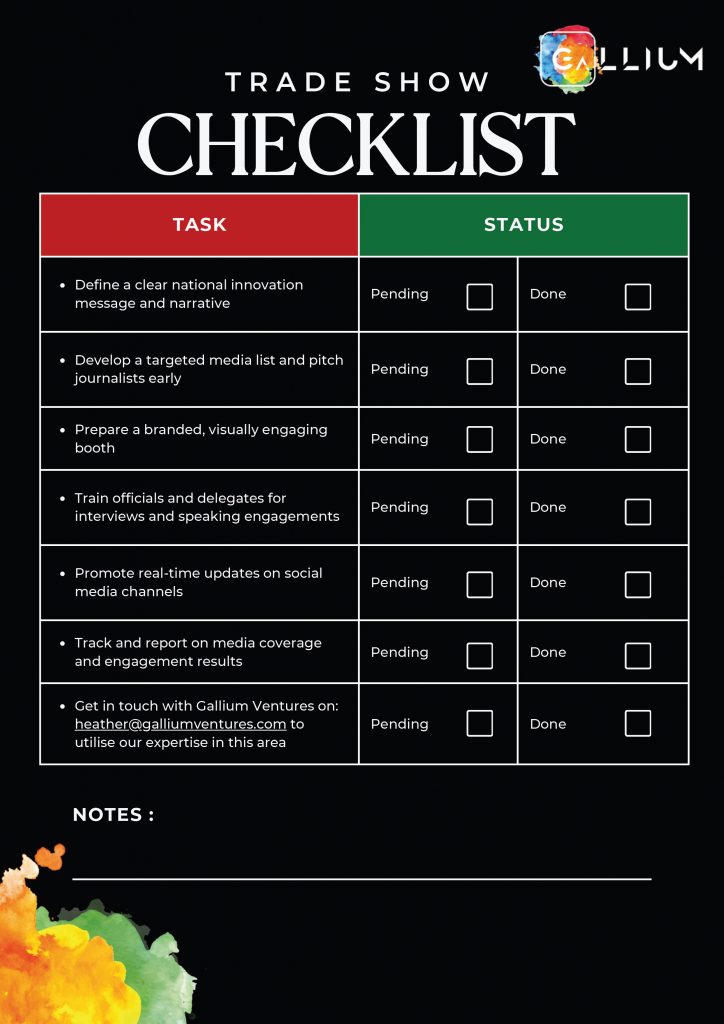Amid a global innovation race, tech trade shows like IFA in Berlin, VivaTech Paris, and CEATEC Tokyo, are no longer exclusive to startups and tech giants showing their latest products, they’re key platforms for governmental entities too.
That said, and as much as participation can be beneficial, it needs to be preceded by meticulous planning to make it effective. Here at Gallium, we are honored to have worked with a number of governmental entities over the years to prepare them for similar events. So, here are a few lessons we learned along the way.
Why government participation in trade shows matters
Before diving into what’s needed for successful participation, let’s identify some of the key purposes and motivations for governmental entities to participate in global tech trade shows.
1. Attract foreign investment and talent
Trade shows attract a large crowd of venture capital firms, tech giants, startups, and global media, all under one roof. A well executed governmental presence can highlight a country’s national tech policies, investment incentives, and startup support programs. Doing this on ground, on a strong foot, and with a well executed plan, sends a strong message to potential investors and entrepreneurs that your country is open for and supports innovation.
Another important reason to get involved is to encourage those companies to open offices/branches within their local countries. This way, governments can ensure that local talent remains local to contribute to the growth and prosperity of the nation working for notable companies.
2. Promote national tech and innovation ecosystems
By showcasing your country’s local startups, companies, and R&D institutions, governments taking part in similar events have a chance to tell a compelling story about their countries or states’ role in the global landscape. Additionally, these entities’ exposure on an international scale not only promote exports, but also enhance domestic credibility and pride in national innovation efforts.
3. Strengthen soft power and policy influence
All major trade shows, including the ones we’re discussing in this blog, offer golden speaking opportunities, decent media visibility (when planned properly), and bilateral meetings potential. Participating governments are usually offered the opportunity to sponsor some of these panels and speaking slots, giving them an opportunity to shape global conversations around the topics like AI ethics, sustainability, digital regulation, healthtech, and much more. This builds policy influence and soft power in an increasingly competitive global ecosystem.
What governments need for a successful presence
The key goals identified above are all well and good. However, without prior effective planning, governmental entities expose themselves to the possibility of making astronomical payments on booths and flying out companies and teams on the ground for little to no impact. So, what’s actually needed for success? Let’s give you another list.
1. Clear messaging, goals, and unified branding
Government booths often fall short in similar events with their stories not being made clear. A central narrative needs to be created in line with the participation goal. For example, do you want to portray your country as a hub for climate tech? A pioneer in AI innovation and regulation? Whatever the goal, this must be clearly communicated in brochures, banners and verbal communications. Even the companies selected for attendance to represent your country need to align with your goals.
2. A strong, diverse delegation
The involvement of startups, research institutions, regional bodies, and agencies is key to showcase the seriousness of your country and the wealth of talent within it. However, it’s also crucial to showcase the diversity of business arms your country offers, and the range of expertise. What’s more important is the delegation’s knowledge in their areas of expertise. Each member must be able to speak comfortably, and knowledgeably to their areas of prowess, preferably in a global language like English but more importantly, the local language to where the event takes place.
3. A robust attendance plan
Once the above is checked off your list, you might rightfully ask about the suitable timeline to begin planning for attendance. From experience, we’d suggest a 4-5 months timeline. A government entity needs to factor various elements of planning, these include booth designing, marketing campaigns to amplify attendance, organising VC and partner events to meet with companies (particularly startups), selecting the attending companies, and finally, work on a bespoke media plan to maximise attendance gains.
One of the stronger features of what’s needed when it comes to government entities attending global tradeshows like CES, CEATEC, or GITEX is without doubt profile visibility and enhancement, and who’s better than the media to give you that? Hence, once your list of companies is finalised, you need to partner with an experienced PR agency to start your media planning.
Your PR team needs time to pull together the perfect list of attending journalists and influencers, to get in touch with them and make them aware of your presence and that of the brands you are taking with you, and what they can expect from stopping by at your booth, and allow them time to ask questions.
On the ground, the spokespeople from the delegation need to be media trained and ready to respond to any media enquiries related to the companies in attendance and any government initiatives relevant to the event. Here at Gallium, we focus on training founders in attendance to ensure that they can seamlessly interact with the media and tell their business stories. This training usually benefits the trainees during an event and beyond, resulting in great business results in the long-term.
Trade shows success checklist:
To recap, trade shows are key to building international relationships with different stakeholders from across the globe, and to showcase your country’s capabilities in any industry space. However, they can be very expensive and disappointing if not utilised properly. Below is a checklist of the key things to keep in mind for success:




